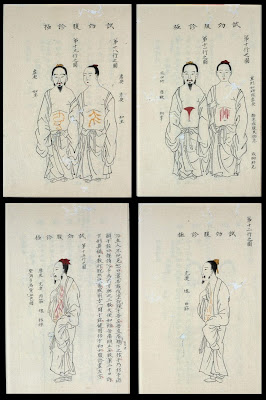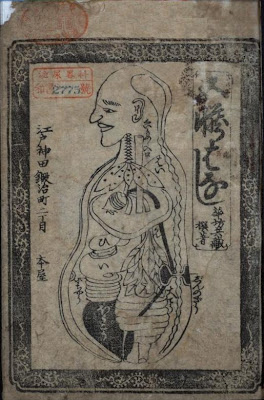

Gozonoshugonarabin (undated)
I *think* some of those objects are meant to be body organs.
I *think* some of those objects are meant to be body organs.


Zentaishinron, 1854
comparative anatomy
comparative anatomy



Orandakinso (undated)
I think those circular figures are the legend for the anatomy points
(pressure or energy or acupuncture) in the body charts. [It took me a
while - I thought they were cross sectioned veins or blood cells at first]
I think those circular figures are the legend for the anatomy points
(pressure or energy or acupuncture) in the body charts. [It took me a
while - I thought they were cross sectioned veins or blood cells at first]

Shinkyokuzusetsu (undated)


Kotsudoseigozusets, 1744

Majimaganryonozu (undated)
All the different flavours of pinkeye.
All the different flavours of pinkeye.

Meikakyusensanpen (undated)
Umm...
Umm...

Naikeizusetsu (undated)
I'm sure I've posted that figure on the right previously. You have to wonder
how they came to be so stylized. Ignorant artist? Intentional for teaching
purposes? Or perhaps it was just the result of copying from a narrow range
of source material during the foreign exclusion in the 17th/18th/19th centuries?
I'm sure I've posted that figure on the right previously. You have to wonder
how they came to be so stylized. Ignorant artist? Intentional for teaching
purposes? Or perhaps it was just the result of copying from a narrow range
of source material during the foreign exclusion in the 17th/18th/19th centuries?

Hobakuzushikifugen (undated)


Hosonozu (undated)
I'd be thinking 'alien impregnation' rather than dermatological
condition if I woke to see anything like those faces in the mirror.
I'd be thinking 'alien impregnation' rather than dermatological
condition if I woke to see anything like those faces in the mirror.

Juteikaitaishinsho, 1843
The artist had obviously been perusing European anatomy texts.
The artist had obviously been perusing European anatomy texts.

Kodomosodaturuoshi, 1840
'How to silence and change your baby at the same time'.
Actually, there was another book with a very similar illustration but it
was more in the way of clearing a choking child's mouth. However, the poses
and the faces here don't really project 'care' so much as rabid infanticide.
'How to silence and change your baby at the same time'.
Actually, there was another book with a very similar illustration but it
was more in the way of clearing a choking child's mouth. However, the poses
and the faces here don't really project 'care' so much as rabid infanticide.


Gozobanashi (undated)


Gyuzansenseikeirak (undated)


Anpukuzukai, 1827

Geryohiroku (undated)
[click to enlarge images to full size]
This assembly of illustrations comes from the first half of the 112 rare Japanese medical texts online at Kuyshu University ('List of Titles').
Many of the 56 books are are more like short pamphlets and there are a couple of herbals and 2 or 3 books on devices such as instructions to build a humidifier. As you can see above, a lot of the pages have suffered extensive silverfish or other vermin damage, so it's a good thing they've digitized the collection. I'll look through the other half of the books in the future.
Addit: See Part Two.
LOL
ReplyDeleteNice looking pics you've collected. Especially the insects. Beeeeeeeautiful!
ReplyDeleteI come here all the time, this is one of the best blogs I´ve ever seen.
ReplyDeleteGreat images!
You have found interesting pictures, which are for sure the state of knowledge at that time.
ReplyDeleteNevertheless, they are culturally determinded (Chinese-Japanese).
Some of your suspicions come close to the fact, but by far not all.
It could be helpful to involve a Japanese transltor of the commentaries.
The pimples on the face (my own experience) are from an WIND-and SUN-Allergy. It was cured by traditional medicine (in Vietnam), whereas the second traditional doctor changed the recipy.
Thanks for your comments Oliver. It *would* be useful to have a translator and if anyone passing through wants to take a crack, please feel free to help out with a comment!! Anyway, even after 6 or so years, seeing the (let's face it: humorous, at times) stylised presentation, doesn't change the way I react to some of these illustrations and I don't regret anything I've written here, no matter how inaccurate it may ultimately be found to be. There's no harm in a having a bit of fun and some wild conjecture!
ReplyDeleteI spent a couple of years living in Vietnam; I'm very aware of the widespread cystic acne that many SE Asian young people (esp. guys I believe) seem to suffer from. I think you're very lucky to find a natural remedy; I have enough of a medical background to know that many of the people who have a severe form of the condition really need drugs like Roaccutane (and no doubt others). I haven't gone reading, but I'd bet there's more diet/genetics involved in the cystic variety than mere sun/wind "allergy". But, again, I'm engaging in some (educated) conjecture on a non-professional site. Everyone should of course see their own doctor / do their own reading and the polysuch.